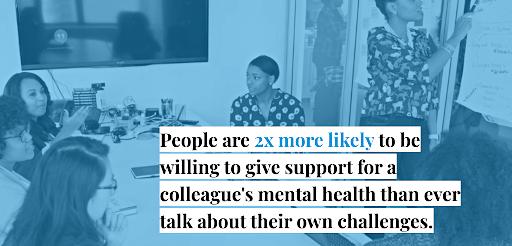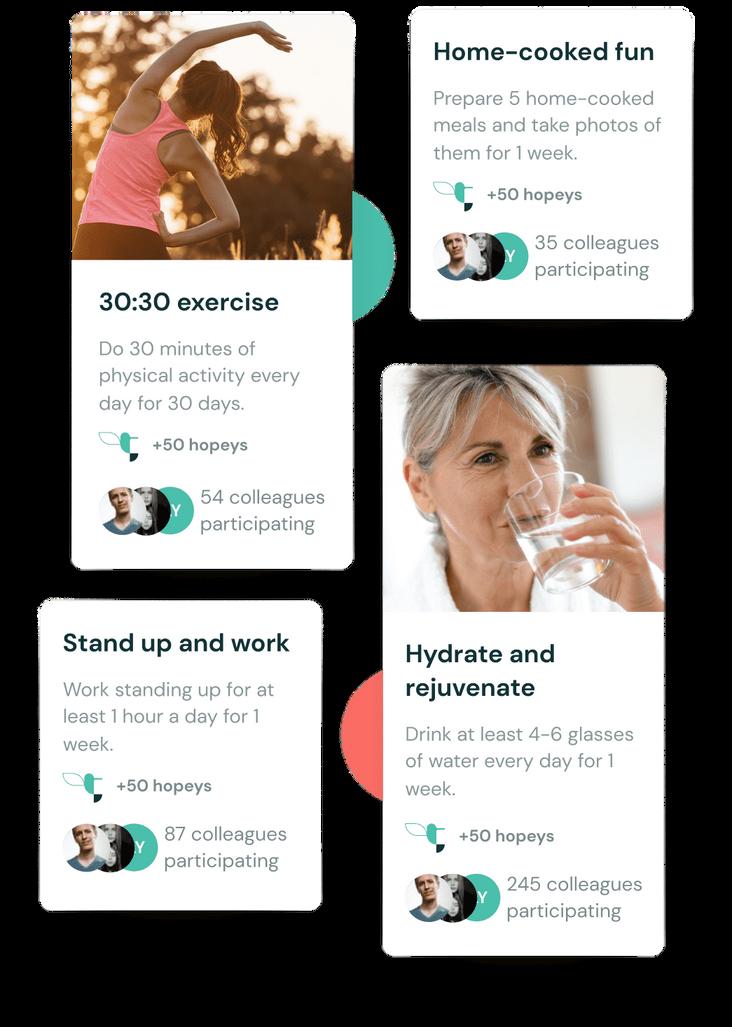MentalHealth Awareness


Your Guide to Mental Health in the Workplace
guide
When was the last time you reassessed how your company addresses mental health in the workplace? It may be a good time to consider setting up some new policies, applying some culture changes, and implementing positive initiatives that drive support and inclusivity for mental health. In this guide, we’ll walk you through how you can better support mental health within your own business and build an inclusive and safe workplace for everyone that enters your (virtual) doors and beyond.

Table of Contents
mental health awareness
progression of mental health awareness
importance
health
mental health
micro-actions

Why
The
The
of supporting
in the workplace How to support mental
in the workplace Team activities and
for boosting mental health How to launch a workplace mental health campaign 3 4 6 10 13 18
2
Mental health matters
Mental Health Awareness days, like World Mental Health Day on October 10th, aim to educate the world on mental health, bring awareness to the topic, and collectively advocate against any mental health discrimination people may be experiencing.
Celebrating such awareness days or simply setting up a mental health policy at work helps destigmatise the topic and remind us all to take a moment to prioritise our personal wellbeing.

In light of this, we've put together a guide to help companies better support mental health globally. We hope you find this guide helpful! Feel free to let us know of any mental health initiatives you are running for this empowering day.

What is employee mental health?
Before we begin, let’s explore what employee mental health is.
The World Health Organisation (WHO) defines mental health as “a state of well-being in which an individual realises [their] abilities, can cope with the mental stresses of life, can work productively and is able to make a contribution to [their] community.”
The WHO also emphasises that mental health is about more than the absence of mental disorders, but rather people’s overall state of mental wellbeing. This is what makes supporting mental health in the workplace so important; it applies to everyone. It’s your employees' wellbeing.
What is World Mental Health Day?

3
The progression of Mental Health awareness
The conversation around Mental Health has been on the rise in recent years, as people are increasingly encouraged to discuss topics related to mental wellbeing.

The COVID 19 pandemic has only heightened the need and urgency to focus on mental wellbeing, as the situation has, and continues to, impact people all over the world.
According to the WHO, mental health concerns arising from the global pandemic are mainly related to:
Fear, worry and stress related to health and uncertainty more broadly. Significant changes to our daily lives (restricted movement, working from home, new sanitary measures, insecure employment, childcare and limited physical contact).
It goes without saying that people have had to adapt to significant changes to their workplaces. Estimates indicate that:
40%
of full-time workers in the European Union (EU) started working remotely due to the pandemic, compared to around 5.4% beforehand.
2/3
of American employees are working from home due to COVID-19, compared to around 7% beforehand.
4The progression of Mental Health awareness
60% over around
of employees said their company could do more to support mental health and emotional stress during the pandemic
of employees experienced burnout due to the pandemic
nearly 50%
of employees under the age of 30 reported feeling anxious.
Essential workers are mostly excluded from these work-from-home statistics. However, their workplaces have also been turned upside down due to the global pandemic. A Center for Disease Control & Prevention study found that more than half of essential workers struggled with mental concerns in 2020—25% more than the general population.

5
75%
The importance of supportingmental health in the workplace
There are three parts to employee wellbeing:
Physical Mental Social
It’s any company’s responsibility to its employees to support all three parts of employee wellbeing plus there are some fantastic benefits to doing so.




Investing in workplace mental health is a win win in the short and long term: it improves employee productivity, satisfaction and retention and sets a positive example in your professional community.

The importance of supporting mental health in the workplace
Many employers have trouble
determining where their mental health responsibilities begin and end, especially with much of their staff working remotely.
However, a recent study by the Robert Walters group showed that 99% of employers and 97% of workers agree that businesses are responsible for supporting their employees’ mental health.
6
Employers should also be aware that investing in workplace mental health been shown to tangibly benefit businesses. Consider the following example
1. Improved employee performance & productivity

Put simply, employees that are in a good state of mental health work more effectively and produce better results. No one is at their most productive when tr to soldier through a difficult period without adequate support.
Businesses with mental health action plans see benefits such as increased achievement of workplace goals, minimised productivity loss, and higher total ho worked over time. This is largely due to a reduction in presenteeism, absenteeism and compensation claims, which, for example, a 2014 study found cost Australian companies a whopping £9.6 billion per year.
2. Reduced absences
Poor mental health leads to employees needing to take more time off. In fact, evidence suggests that 12.7% of sick days in the UK can be attributed to mental health conditions, making them one of the main causes of workplace absences. Having strong mental health support in the workplace can help prevent this.
The
7
importance of supporting mental health in the workplace
3. Increased employee morale & retention
Happy employees are better workers, easier to collaborate with and contribute to a more positive professional environment. They’re also more likely to stay with your company for longer, allowing you to retain talent and develop an experienced team with minimal turnover.
This is especially relevant nowadays as Mind Share Partners 2019 Mental Health at Work report revealed that 50% of millennials had left jobs for mental health reasons.
4. Financial savings
Poor mental health ends up costing companies money, and lots of it. Tellingly, a 2020 Health & Safety Executive study found that better mental health in the workplace has the ability to save businesses up to £8 billion per year.
Bell Canada also reported that every dollar invested in mental health programmes had a return-on-investment (ROI) of $4.10 in 2018.
Similarly, a 2014 Australian study calculated an average ROI of 2.3 for companies that invested in mental health initiatives across various industries and actions.
The importance of supporting mental health in the workp ace


Source

8
5. Increased professionaldevelopment and engagement

There’s a significant link between mental health and sense of purpose in the workplace. When workers feel like their work is truly meaningful, their sense of wellbeing improves. They’re also more likely to feel engaged, prioritise professional development activities, and make useful professional contributions that ultimately benefit everyone involved.
"Theimpactofvolunteering&givingonemployee wellbeingaresosignificantthatAlanRozanski,a cardiologistinNewYorksaysthatpurposeisactually themostsignificantdriverofwellbeing.It'smore importantthanexercise.Andit'smoreimportant thanquittingsmoking"

BEA BOCCALANDRO
Author of Do Good At Work Source
The importance of supporting mental health in the workplace

9
How to support mental health in the workplace
Just like there’s no quick fix for mental health, there’s no quick fix for supporting employee mental health. Nevertheless, there’s a limitless amount of ideas, initiatives and techniques out there that can help support and promote mental health in professional environments.
Check out some of our favourite ideas, then do some brainstorming and pilot some initiatives to figure out what will work best for your company.
1. Connectwithnonprofits & other organisations that focus on mental health.
If you don t know where to start when investing in mental health in your workplace, this is a great option.
Connect with nonprofits and organisations that focus on mental health and ask them if they’d be open to making a presentation to your leadership team to give them ideas and guidance regarding company-wide mental health initiatives.
They might even be willing to make a presentation to your employees about mental health in general. This is also a great option for remote teams as everything can be organised online.
Some examples include:
Mental Health Europe Mind
European Network for Workplace Health Promotion
This is such an important step to take for better employee wellbeing. Small actions, challenges, and volunteering options enable your employees to do good to feel good. This is critical for building a resilient company culture.
How to support mental health in the workplace

10
2. Promote smallactions that improve mental health & wellbeing
This is another ideal initiative for remote or spread out professional teams as employees can participate no matter where they’re located: at home, in the office or on the front lines.
Encourage employees to complete tasks or challenges that support mental health
every week, or even every day. They can be done as a team or individually. Motivate employees to participate even further by assigning points to these tasks or encouraging them to share their experiences on social media or platforms like Benevity.

Check out these ideas of small actions that support mental health. Provide a variety of choices, as these challenges work best if they align with employees’ individual personalities and senses of purpose:

Volunteering for a charitable cause in your community.
Disconnecting from electronics for 2 hours before you go to sleep.
Going for a 15-minute walk during your work day.
Writing in a gratitude journal every evening for a week.
Participating in a fun fitness challenge doing yoga for 20 minutes every day for a month
11How to support mental health in the workp ace
3. Set up policies&resources for mental health support
Don’tjusttalkthetalk,walkthewalk.Establishtangiblepoliciesandresourcesin yourworkplacethatprovideemployeeswitheffectivetoolstouseifthey’re strugglingwithmentalhealth.Atleastsomeofthesetoolsshouldprovideadegree ofanonymity,asmentalhealthissuesarenoteasyformosttotalkabout.
Provideflexibleworkinghoursortheopportunitytotakefullorhalfdaysofffor mentalhealthreasons,noquestionsasked.
Establishpolicieswhereemployeescanuseacertainamountofworkinghours foractionsmentionedabove(likegoingtothegym,volunteeringintheir community,makingdonations,orparticipatinginteambuildingevents). Createalistofmentalhealthresources(likenursehotlinesorcounsellors)that employeescancalliftheyneedsupport.Makesureemployeesknowwhere theycanfindthislist.
Thinkinglong-term,implementmentalhealthsabbaticalsthatemployees cantakeafterworkingwithyourcompanyforacertainamountoftime. Organisecompanywidedaysoff,eventsand/orretreatsperiodically.
Considerputtingtogetheremployeerecreationalsportsteamsororganising otherfunstaffevents.
Publiclyownthefactthatyourcompanycaresaboutemployeemental healthandtalkaboutit.
Encourageemployeestostayactivebyprovidingstipendsforgym memberships,negotiatingadiscountedratewithagyminyour communityorinvestinginshowerfacilities(inthecaseofoffices)so thatemployeescanbikeorjogtoworkortakeanactivelunchbreak.
Helpemployeesalignthemselveswiththeirprofessionalpurposeby investinginprofessionalandpersonaldevelopmentactivities. Sendemployeesperiodic,anonymousmentalhealthandgeneral well-beingsurveysandtaketheirfeedbackseriously.
Implementpoliciesregardingworkinghours(aswellasbreaks throughouttheday),andhelpemployeessticktoareasonable schedule.
Acknowledgeandcelebrateemployeesuccesseslikepromotions andanniversaries.
Remember,supportingmentalhealthintheworkplaceshouldmaximise youremployees’overallsenseofwell-being.Itcanhelpthemfeel connectedwiththemselves,theirpeersandtheircommunityand encouragethemtofindasenseofdeeperpurposeintheirdaytoday lives. Formoreinformationonhowinvestinginemployeepurposeis beneficialforyourbusiness,clickhere.
12How to support mental health in the workplace
Team activities for boosting mentalhealth



13
Stroll and clean: Community cleanupday
Take your teams outdoors! Organise a day of fresh air and give back to the community. Community clean ups are easy to organise and get your teams tog to socialise in a new way while doing good. And, of course, Mother Earth will th you, too, because the waste humans produce is an enormous strain on the environment. It pollutes ecosystems, animals mistake litter for food, and toxins into the soil or water. You can organise cleanups by yourself or in partnership nonprofit.

Important: Make sure you're familiar with your city's/region's regulations for th kinds of public events and have a plan ready for disposing of the collected tras

When in doubt, call a local waste management facility.

14Team activities for boosting mental health
Share what makes you happy

Motivate employees to reflect and think of things that make them happy. For example, you could put up a physical bulletin board in your office and/or creat new channel on your company-wide messaging tool and ask employees to sha what little things lift their mood.

Plan an Activity to simply spark a conversation and have employees come together and learn more about and from each other. Or organise a friendly competition to see how well your colleagues know ea other. Ask them to send in their answers to a set of questions and then hav them guess who gave which answer. As an incentive, you could give the per with the most correct guesses a voucher to make a donation to a nonprofit their choice.

15Team activities for boosting mental health
Take some time to give kudos
At every company, there are some positions that get more visibility than others difficult to avoid this. But you can make an effort to recognise contributions by single person in your company. Create a space for employees to give thanks an shoutouts to each other - for whatever they want to show their appreciation fo doesn't have to be related to their work, get creative!
You could give shoutouts to people who...
Are always happy to help out others
Have interesting hobbies and inspiring passion for it

Provide a calm, positive presence in the workplace


Have a great sense of fashion
Have a contagious or endearing laugh
Have great taste in music / movies / books
You can create a shared doc for everyone to leave their comments in, give out p its to create a kudos wall in the office, and/or ask employees to share their kudos in your company-wide messaging channels.
Team activities for boosting mental health
16

17How to support mental health in the workplace Six micro-actions to encourage employees to learn about mental health Write 3 things you're grateful for in your journal at the end of the day Sleep a full 8 hours every night1 4 Meditate for 10 minutes a day Eat whole foods that fuel your brain with power to support mental health2 5 Practice box breathing every day for 10 minutes Go for a 30 minute walk every day3 6
How to launch a workplace mental health campaign

If you re looking to take things a step further and launch an entire campaign, then read on. We’re about to dive into the specifics on what you need to do to launch a workplace mental health campaign this year.

1. Define your campaign concept and scope
A great first step is to first define what you want your campaign to be, set your goals, and how you can achieve them. Start with some research on the topic, get involved, look for ways to bring it to your company.
Identify the strengths and weaknesses of different campaigns and align them with your business mission.
2. Involve stakeholders & get buy-in
It is important to get everyone involved in the discussion. Prepare a campaign overview including a timeline, teams involved (e.g. Comms, leadership, etc), the technology required, deliverables and other resources required.
How to launch a workplace mental health campaign

18
3. Prepare internalcommunications
Think about the communication strategies you’ll use to make sure your campaign gets into your employees’ hands.
Emails
Intranet posts
Posters
Flyers Videos
Discussion guides for people managers


Remember to consider any non desk workers and how you’ll reach them.
4. Prepare external communications
It’s important to share, not just with your employees, but with all your community what you are doing, how you are engaging around the cause, and your commitment. It can be a powerful source of pride to your employees and future candidates to know that your company cares about WMHD and their employees’ wellbeing.
5. Kickoff your campaign
Launch your campaign with a bang! Hit publish, send out the invites, videos, and event registration information to your employees and other stakeholders. Remember to keep the momentum with reminders.
How to launch a workplace mental health campaign
19
Trackyour impact Donation& Fundraising
It’s rewarding for your business and your employees to see the impact your efforts have had on the community. There are many ways to analyse this. Here are a few KPIs to report on:
How many employees engaged with the initiative?
How much money/goods did you raise? Which departments were most engaged? What aspects were most successful?
It’s also a good idea to invite feedback from employees surrounding the mental health engagement. By doing so, you’ll be able to optimise your mental health programme for the future and qualitatively report on your success with employee stories. This feedback is also great information to share with your online community. Presenting the facts surrounding your organisation’s impact shows your commitment to genuinely supporting your employees. It’s not enough for a company to say they want to help—they need to put the work in to make it happen and report on it after.
May2020June2020 July2020August2020September2020October2020November2020December2020January2021February2021March2021 April2021
Direct Donation Fundraising Volunteering
Skills Volunteering Field Volunteering
April2020May2020June2020July2020August2020September2020October2020November2020December2020January2021February2021March2021April2021 500 400 300 200 100 0 April2020
300 200 100 0
20How to launch a workplace mental health campaign 6.
y an opp ellbeing
hallenges for ma
opportunity to prioritise mental health in the w for the years to come.
Strong employee well-being and mental health businesses, improves overall employee attitude and sets a great example for your professional when mental health is prioritised in the workpla

Hopefully, you found this guide useful and can throughout the year. Latch on to the opportuni force to create a more inclusive, safe, and supp mental health.

21Make everyday an opportunity to invest in workplace wellbeing
Have questions?
We'reheretohelp

Benevity, a certified B Corporation, is the leader in global corporate purpose software, providing the only integrated suite of community investment and employee, customer and nonprofit engagement solutions. Recognized as one of Fortune’s Impact 20, Benevity offers cloud solutions that power purpose for many iconic brands in ways that better attract, retain and engage today’s diverse workforce, embed social action into their customer experiences and positively impact their communities. With software that is available in 22 languages, Benevity has processed more than $10 billion in donations and 46 million hours of volunteering time to support 326,000 nonprofits worldwide. The company’s solutions have also facilitated 770,000 positive actions and awarded 1.2 million grants worth $12 billion. For more information, visit benevity.com.

Get a Demo


































